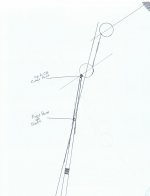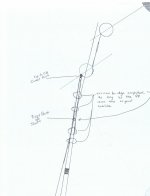If you look at the below illustration, you'll see two things illustrated.
How PPA (Pivot Point Aiming) works and how to find the correct initial aim line.
You'll see that there is a line drawn through the center of the OB leading to the pocket and then a parallel line drawn through the center of the CB.
The point on the BACK of the OB that this line intersects represents the CP (contact point) on the OB.
The point of the line that intersects the FRONT of the CB represents the CP on the CB.
If you line those two points up and then have a parallel line that goes through the center of the CB, that represents the initial correct center ball aim line.
Once you have that line (as a starting point) PPA is all about ensuring that the PP of the cue you are using falls on that point. It shouldn't matter what type of english you are using although as I have stated the more parallel the cue's shaft is to the playing surface, the less of an effect swerve becomes.
For medium to hard shots, this makes PPA very accurate, even on tight tables. There is some variation, it is not 100%, but it is accurate enough for the majority of medium to hard shots even on tight tables to be virtually indispensible IMO.
Ignore that the CP between the CB and the Cue is right on top of the line going through the CB that is parallel to the OB path line, that is just happen stance, it doesn't matter how much or what type of side spin you are using.
Also, the closer the CB is to the OB, the less speed has an effect and the slower you can shoot without adjusting your initial aim.
Jaden
How PPA (Pivot Point Aiming) works and how to find the correct initial aim line.
You'll see that there is a line drawn through the center of the OB leading to the pocket and then a parallel line drawn through the center of the CB.
The point on the BACK of the OB that this line intersects represents the CP (contact point) on the OB.
The point of the line that intersects the FRONT of the CB represents the CP on the CB.
If you line those two points up and then have a parallel line that goes through the center of the CB, that represents the initial correct center ball aim line.
Once you have that line (as a starting point) PPA is all about ensuring that the PP of the cue you are using falls on that point. It shouldn't matter what type of english you are using although as I have stated the more parallel the cue's shaft is to the playing surface, the less of an effect swerve becomes.
For medium to hard shots, this makes PPA very accurate, even on tight tables. There is some variation, it is not 100%, but it is accurate enough for the majority of medium to hard shots even on tight tables to be virtually indispensible IMO.
Ignore that the CP between the CB and the Cue is right on top of the line going through the CB that is parallel to the OB path line, that is just happen stance, it doesn't matter how much or what type of side spin you are using.
Also, the closer the CB is to the OB, the less speed has an effect and the slower you can shoot without adjusting your initial aim.
Jaden
Attachments
Last edited:

